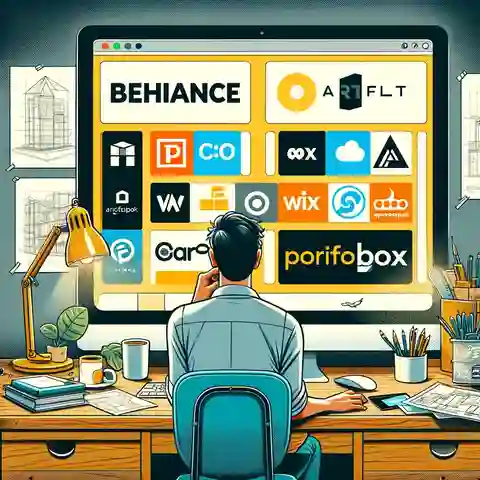Creating the best architecture portfolio website is like making a scrapbook of your best work, but this one helps you get your dream job! It shows off your designs, ideas, and what makes you a great architect. Here are the 10 best architecture portfolio websites:
The 10 Best Architecture Portfolio Websites

Making a cool online portfolio is important for architects. Here are 10 websites where you can make your portfolio:
1. Behance
Behance lets lots of creative people share their work. It’s part of Adobe, so lots of people can see what you make.
2. Archinect
This site is just for architects! You can show your projects and find job ads too.
3. Coroflot
Coroflot is for all kinds of designers, including architects. It helps you show your work to others and find jobs.
4. Portfoliobox
You don’t have to be a computer whiz to use Portfoliobox.
5. Cargo
Cargo has really fancy templates that are perfect for showing off your architecture projects.
6. Squarespace
Squarespace is famous for its beautiful designs and it’s easy to use, so you can make a professional-looking portfolio.
7. Wix
Wix is super flexible. You can drag pictures and text around to make your portfolio look just the way you want.
8. Adobe Portfolio
If you use Adobe software, Adobe Portfolio is perfect because it works smoothly with all Adobe apps.
9. WordPress
WordPress lets you do almost anything! You can choose from thousands of designs to make your portfolio stand out.
10. Format
Format is simple but powerful, making it easy for architects to build beautiful portfolio websites.
Why These Sites Are Awesome:
- Make It Your Own: You can change how your portfolio looks to match your style.
- Get Noticed: Lots of people visit these sites, so potential clients or bosses can see your work.
- Easy Peasy: These websites are easy to use, whether you’re good with computers or not.
- Share Everywhere: Some of these sites let you connect with social media, so it’s easy to share your work with even more people.
How to Building a Professional Architecture Portfolio

Here’s how to make an awesome portfolio:
1. Choose Your Best Work
- Pick projects that show different skills, like drawing, designing buildings, and making models.
- You want to show you can do lots of things really well.
2. Tell a Story
- For each project, explain how you started, what you did, and how it ended up. Add pictures and drawings to make it interesting.
- It helps people understand your work better and see how creative you are.
3. Keep It Neat
- Organize your portfolio so it’s easy to look at. Use clear titles and put your work in order.
- A neat portfolio makes a good impression and helps people find what they’re interested in.
4. Go Digital
- Make a digital version of your portfolio. You can use websites or apps to show your work online.
- Lots of people look for architects online, so a digital portfolio can help more people see your work.
5. Update Regularly
- Add new projects and take out old ones to keep your portfolio fresh.
- New work shows you’re always getting better and learning new things.
6. Get Feedback
- Show your portfolio to friends, family, and teachers. Ask them what they think.
- They can give you good ideas to make your portfolio even better.
7. Show Your Personality
- Add something about you, like your favorite projects or what you love about architecture.
- It helps people get to know you and see if you’re a good fit for their team.
8. Practice Your Presentation
- Be ready to talk about your portfolio and explain your work to others.
- Talking well about your work can impress people and help you get jobs.
What is an architecture portfolio?

An architecture portfolio is like a big photo album but for your architecture work. This album helps show how creative and skilled you are at making buildings and spaces.
It’s important because it helps other people, like bosses or clients, see what kind of cool things you can create.
Why is an architecture portfolio important?

An architecture portfolio is important because it’s like your personal showcase. Here’s why it’s so special:
1. Your Professional Storybook
- Your portfolio tells the story of your work, your skills, and your journey in architecture. It’s your professional diary that shows where you’ve been and where you’re heading.
- People who might want to hire you or work with you can see your talent and how you think and create.
2. First Impression Counts
- Often, your portfolio is the first thing employers or clients see.
- A strong portfolio makes a great first impression, showing you’re serious and talented.
3. Shows Your Skills and Creativity
- It’s not just about the final look of a building or space.
- Employers and clients are looking for creative thinkers, not just good drafters.
4. Helps You Stand Out
- In a world full of architects, your portfolio highlights what’s unique about you and your work.
- It can be the difference between getting your dream job or project and just being another applicant.
5. A Tool for Reflection
- Putting your portfolio together makes you look back at your work, see how much you’ve grown, and where you can improve.
- This reflection can guide your future learning and career decisions.
6. Versatile Use
- You can use your portfolio in many ways – applying for jobs, pitching for projects, or even applying for further education.
What should include in portfolio?

Here’s what you should include to make your portfolio shine:
1. Cover Page
- Your name, profession (Architectural Designer, for example), and contact information.
- Sets the tone and makes a professional first impression.
2. Introduction or Bio
- A brief introduction about yourself, your design philosophy, and what drives your work.
- Gives a personal touch and helps viewers understand your approach to architecture.
3. Table of Contents
- A clear list of the projects included with page numbers.
- Makes navigation easier and shows organization skills.
4. Project Pages
Each project should ideally include the following:
- Title and Location: Name of the project and where it’s located.
- Brief Description: A short overview of the project, including your role.
- Concept and Design Process: Show your initial sketches, concept development, and how you solved design challenges.
- Visuals: Include high-quality images, renderings, drawings, and models. Before and after photos can be very impactful for renovation projects.
- Final Outcome: Highlight the finished project with photos or 3D renderings.
- Why It’s Important: Demonstrates your skill set from conceptualization to completion.
5. Technical Skills
- Software proficiency (like AutoCAD, Revit, SketchUp, Adobe Creative Suite), model-making, hand-drawing skills, and any other relevant skills.
- Shows your versatility and competence in necessary tools and techniques.
6. Academic Work
- If you’re a student or recent graduate, include your best academic projects that show your potential.
- Highlights your learning and growth potential, especially if you have limited professional experience.
7. Professional Work
- Projects you’ve worked on professionally. Clearly define your role and contributions if it was a team project.
- Demonstrates real-world experience and how you collaborate in a professional setting.
8. Awards and Recognitions
- What to Include: Any awards, competitions you’ve won, publications, or exhibitions.
- Why It’s Important: Validates your work and sets you apart from the competition.
9. Extracurricular Activities
- Relevant workshops, volunteer work, or activities that show leadership and involvement in the architecture community.
- Shows you’re well-rounded and engaged with the architectural field beyond just work and school.
10. Contact Information and Social Media
- Your professional email, LinkedIn profile, and portfolio website if you have one.
- Makes it easy for viewers to contact you and learn more about your work online.
In the End
Picking the right place for your architecture portfolio depends on what you like, who you want to see your work, and how you want to show it off.
Making a professional architecture portfolio is a big step in showing the world how great an architect you are.
FAQs about Building a Professional Architecture Portfolio
How many projects should we include?
Quality over quantity! Choose 5 to 10 of your best projects that show a range of skills and types of work.
Can it include group projects?
Yes, This shows teamwork skills and how you work with others.
Should the portfolio be digital or printed?
A digital portfolio is easy to share online, but a printed version can be impressive during in-person interviews.
How long should the portfolio be?
Keep it concise. Aim for 20-30 pages for a printed portfolio or a similar length for a digital one.
Can you use templates for your portfolio?
Templates can be a good start but try to customize it to reflect your style and personality.
How do you get feedback on your portfolio?
Share it with mentors, peers, and professionals in the field. Attend portfolio review events or workshops.



